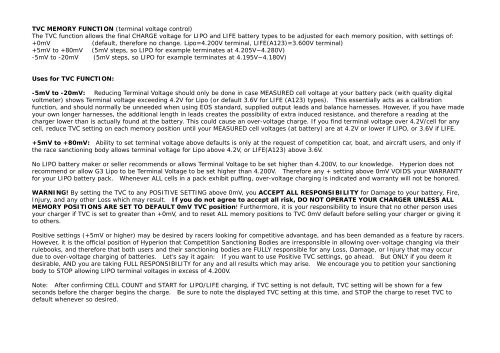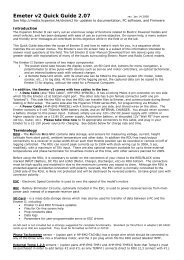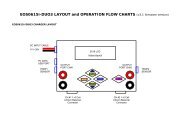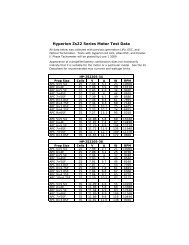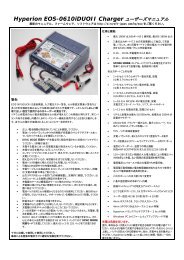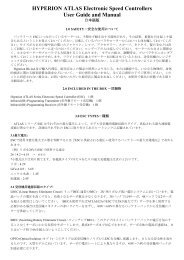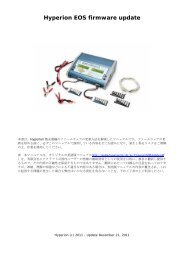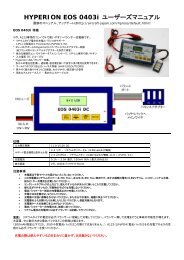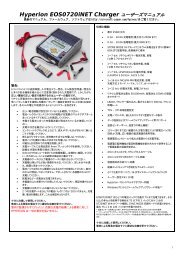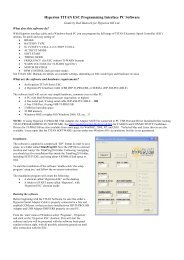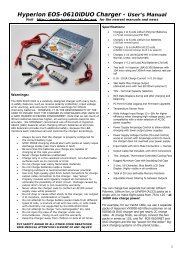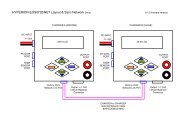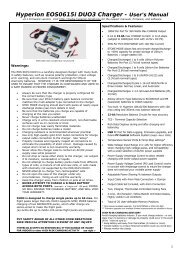SIMPROP INTELLI CONT V3 Manual - Hyperion HK
SIMPROP INTELLI CONT V3 Manual - Hyperion HK
SIMPROP INTELLI CONT V3 Manual - Hyperion HK
Create successful ePaper yourself
Turn your PDF publications into a flip-book with our unique Google optimized e-Paper software.
TVC MEMORY FUNCTION (terminal voltage control)<br />
The TVC function allows the final CHARGE voltage for LIPO and LIFE battery types to be adjusted for each memory position, with settings of:<br />
+0mV (default, therefore no change. Lipo=4.200V terminal, LIFE(A123)=3.600V terminal)<br />
+5mV to +80mV (5mV steps, so LIPO for example terminates at 4.205V~4.280V)<br />
-5mV to -20mV (5mV steps, so LIPO for example terminates at 4.195V~4.180V)<br />
Uses for TVC FUNCTION:<br />
-5mV to -20mV: Reducing Terminal Voltage should only be done in case MEASURED cell voltage at your battery pack (with quality digital<br />
voltmeter) shows Terminal voltage exceeding 4.2V for Lipo (or default 3.6V for LIFE (A123) types). This essentially acts as a calibration<br />
function, and should normally be unneeded when using EOS standard, supplied output leads and balance harnesses. However, if you have made<br />
your own longer harnesses, the additional length in leads creates the possibility of extra induced resistance, and therefore a reading at the<br />
charger lower than is actually found at the battery. This could cause an over-voltage charge. If you find terminal voltage over 4.2V/cell for any<br />
cell, reduce TVC setting on each memory position until your MEASURED cell voltages (at battery) are at 4.2V or lower if LIPO, or 3.6V if LIFE.<br />
+5mV to +80mV: Ability to set terminal voltage above defaults is only at the request of competition car, boat, and aircraft users, and only if<br />
the race sanctioning body allows terminal voltage for Lipo above 4.2V, or LIFE(A123) above 3.6V.<br />
No LIPO battery maker or seller recommends or allows Terminal Voltage to be set higher than 4.200V, to our knowledge. <strong>Hyperion</strong> does not<br />
recommend or allow G3 Lipo to be Terminal Voltage to be set higher than 4.200V. Therefore any + setting above 0mV VOIDS your WARRANTY<br />
for your LIPO battery pack. Whenever ALL cells in a pack exhibit puffing, over-voltage charging is indicated and warranty will not be honored.<br />
WARNING! By setting the TVC to any POSITIVE SETTING above 0mV, you ACCEPT ALL RESPONSIBILITY for Damage to your battery, Fire,<br />
Injury, and any other Loss which may result. If you do not agree to accept all risk, DO NOT OPERATE YOUR CHARGER UNLESS ALL<br />
MEMORY POSITIONS ARE SET TO DEFAULT 0mV TVC position! Furthermore, it is your responsibility to insure that no other person uses<br />
your charger if TVC is set to greater than +0mV, and to reset ALL memory positions to TVC 0mV default before selling your charger or giving it<br />
to others.<br />
Positive settings (+5mV or higher) may be desired by racers looking for competitive advantage, and has been demanded as a feature by racers.<br />
However, it is the official position of <strong>Hyperion</strong> that Competition Sanctioning Bodies are irresponsible in allowing over-voltage changing via their<br />
rulebooks, and therefore that both users and their sanctioning bodies are FULLY responsible for any Loss, Damage, or Injury that may occur<br />
due to over-voltage charging of batteries. Let’s say it again: If you want to use Positive TVC settings, go ahead. But ONLY if you deem it<br />
desirable, AND you are taking FULL RESPONSIBILITY for any and all results which may arise. We encourage you to petition your sanctioning<br />
body to STOP allowing LIPO terminal voltages in excess of 4.200V.<br />
Note: After confirming CELL COUNT and START for LIPO/LIFE charging, if TVC setting is not default, TVC setting will be shown for a few<br />
seconds before the charger begins the charge. Be sure to note the displayed TVC setting at this time, and STOP the charge to reset TVC to<br />
default whenever so desired.


